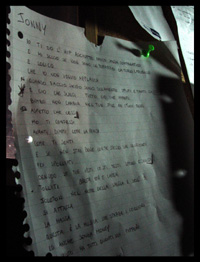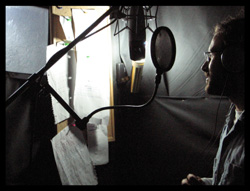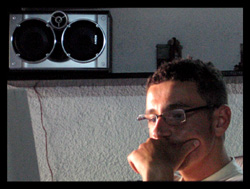 It seems out of place to find a recording studio next to a chicken coop and across from an herb garden, but that’s exactly where Samuel Bucarini produces his hypnotic beats. It seems out of place to find a recording studio next to a chicken coop and across from an herb garden, but that’s exactly where Samuel Bucarini produces his hypnotic beats.
Bucarini, a 20-year-old who lives in Cagli, has always been interested in music. But when it came down to producing one specific type of music, he chose hip hop and rap because of their simplicity. “I would eventually like to get into other [types of] music, but I like hip hop and rap because it’s easy to produce.”
About six years ago, the hip-hop wave penetrated Italy. At the time, Bucarini purchased his first rap CD, 2001, by Dr. Dre, on the recommendation of a friend. He would like to buy another copy of Dr. Dre’s recording because he thinks it is a piece of art. Musically, he buys everything and is inspired by everything from cartoons to movie soundtracks. Two of his favorites include “old-school” R&B artists, Aretha Franklin and James Brown, two icons from the 1960s and 1970s.
He likes music, but has never studied it formally. He has taught himself how to play the piano, guitar and bass. He even likes Mozart because he thinks the composer developed innovative chords. To learn music, Bucarini tries to recreate the chord he hears with his mixer.
 Aside from Franklin, Brown and Mozart, Bucarini sees music producer Scott Scorch as his mentor. Scorch is the creative force behind rap hits such as “Lean Back” by Terror Squad and “Candy Shop” by 50 Cent. Bucarini is a firm believer in Scorch’s four ingredients for a hit: realness, simplicity, a catchy hook, and bounce. At times, Bucarini feels as though this plan for success is a conundrum because it is hard to keep a song simple while offering the listener a catchy hook. “If the song doesn’t have a catchy hook, then you loose the audience – they’ll change the station and listen to something else. Aside from Franklin, Brown and Mozart, Bucarini sees music producer Scott Scorch as his mentor. Scorch is the creative force behind rap hits such as “Lean Back” by Terror Squad and “Candy Shop” by 50 Cent. Bucarini is a firm believer in Scorch’s four ingredients for a hit: realness, simplicity, a catchy hook, and bounce. At times, Bucarini feels as though this plan for success is a conundrum because it is hard to keep a song simple while offering the listener a catchy hook. “If the song doesn’t have a catchy hook, then you loose the audience – they’ll change the station and listen to something else.
As he sits in his oversized leather desk chair, he lights a cigarette and opens a file on his computer containing his latest project. “Loops” are the ideas that he has to work on. One project out of every three that he produces doesn’t work. If he doesn’t like the direction in which the song is headed, he deletes it. But when he likes something that he produces, he describes the feeling as an adrenaline rush when he says he creates something out of nothing.
The best moment for inspiration comes to him when he is driving, so he does not listen to the radio in the car. When he gets an idea in his head, he rushes home to get started on it right away. How he feels in the moment that he is inspired is reflected in his music. If he is happy, then the song will be happy. If he is angry, then the song will be angry.
He does not have a fixed creative process, which is obvious from his computer desktop because it is covered with folder icons. The folders have multiple folders, filled with unfinished projects that he expects to finish some day. Sometimes he knows exactly what he wants to compose; other times, he has no idea.
There is no specific genre of music that influences him the most. He readily borrows sounds from all around the world. Recently, Arab and French rap have influenced his music, introduced to him by a friend from Morocco.
Bucarini has over 150 of his songs to choose from, if he ever decides to put out a CD. At time, he does not consider himself an actual artist; he just likes to have fun in his studio, doing what sounds the best to him.

The studio has been in its current state since September 2005. He originally wanted to set up a studio in his parents’ garage in Cagli, but they said no because it would produce far too much noise in their quiet community. Instead, his parents suggested that he make use of a family-owned barn in a little village about eight miles outside of Cagli called Pianello.
He took on the arduous task of rebuilding the space, all on his own, buying building supplies. His equipment cost a lot of money, but he bought it piece by piece on the Internet. “In Cagli, you can’t even find headphones!” he says.
The only thing that he needs now is a staircase to replace the dilapidated ladder that leads up to the loft. The future of the studio is dubious because once he goes away in September to study at the University of Ancona, he doubts that he will return. He does not like the people in Cagli very much and thirsts for an environment that is more open and accepting of his music.
Bucarini says he thinks Cagli has nothing to offer in terms of hip hop. Neither does Italy, for that matter, he adds. Bucarini says he believes that Italy “lives in the shadow of the U.S.” Over the last couple of years, listening to rap in Italy is like fashion among the young people. Rap is seldom played on the radio.
 Italians who listen to rap become “wannabe gangsters,” says Bucarini. There is a stereotype associated with rap, mostly gangster and marijuana related. All the “wannabes,” he says, want to become drug dealers, a common misconception in Italy. In his opinion, the wannabes think that’s what hip hop is all about. But Bucarini says he believes that if you really like rap, then you “don’t feel like you have to be a gangster.” Italians who listen to rap become “wannabe gangsters,” says Bucarini. There is a stereotype associated with rap, mostly gangster and marijuana related. All the “wannabes,” he says, want to become drug dealers, a common misconception in Italy. In his opinion, the wannabes think that’s what hip hop is all about. But Bucarini says he believes that if you really like rap, then you “don’t feel like you have to be a gangster.”
He has performed at venues in Cagli but did not enjoy the experience because some people who did not understand his music made him feel like an alien in his hometown. Bucarini says he does not plan on working in the music industry. He hopes to study to become a doctor when he goes to the university. He will continue to produce music because it is his passion.
|
